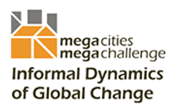The dynamics of peri-urbanization in the Pearl River Delta: Emerging land use patterns, urban villages and their linkages to global mechanisms.
Background and Objectives
This project aims at analyzing the interaction of informal and formal dynamics occurring in peri-urban areas of the Pearl River Delta. Peri-urban areas constitute areas that are neither urban nor typically rural. They need to be defined by typological rather than simple geographical models based on distance from urban centers. Typically, peri-urban areas show a number of functions that are of high significance for the emergence and internal differentiation of mega cities including ecological balance, land resource, hinterland for urban economies, food production and processing, and recreation.
Specifically, it is intended to explore the role and significance of 'urban villages' as an important actor in the emerging mega-urban region of the Pearl River Delta. While their scope of influence is largely local, these informal structures are intertwined with mechanisms of the global economy as is the entire region of the Pearl River Delta. It is assumed that the modes of the formal/informal interaction define the degree of flexibility as well as the 'quality' of the resulting social, economic and spatial patterns.
The project aims at exploring the interplay of various actors in the peri-urbanization processes by studying its modalities, results and inherent contradictions. The underlying general goal is to answer the question as to whether the locational factors and living conditions in the 'urban landscape' can be sustained in the long term through the interplay of formal and informal systems and actors.
Research Team
Berlin Institute of Technology, Faculty IV Planning and Construction- Prof. Dr. Peter Herrle; email: peter.herrle(at)tu-berlin.de
- Dr. Josefine Fokdal; email: josefine.fokdal(at)si.uni-stuttgart.de
- Dr. Sonja Nebel; email: sonja.nebel(at)tu-berlin.de
- Prof. Dr. Birgit Kleinschmit; email: birgit.kleinschmit(at)tu-berlin.de
- Dr. Bodo Coenradie; email: coenradie(at)ile.tu-berlin.de
- Prof. Dr. Detlev Ipsen; email: dipsen(at)uni-kassel.de
- Dipl.-Ing. Holger Weichler; email: weichler(at)uni-kassel.de
Publications
- Fokdal, J., Herrle, P. (2010): Negotiated Space: Urban Villages in the Pearl River Delta. In: Trialog, 2010 (102/10), pp. 10-15
- Herrle, P., Ipsen, D., Nebel, S., Weichler, H. (2008): Wie Bauern die mega-urbane Landschaft in Südchina prägen. Zur Rolle der "Urban Villages" bei der Entwicklung des Perlflussdeltas. In: Geographische Rundschau, 60 (11), pp. 38-46
- Herrle, P., Fokdal, J. (2011): Urban Informality Discourse: Negotiating Power, Legitimacy and Resources. In: Geographische Zeitschrift , 90 (1), pp. 3-15
- Herrle, P., Fokdal, J. (2012): Dörfer in der Stadt - Städter auf dem Land. Wohnen im Pearlflussdelta in Südchina. In: Harlander, T., Kuhn, G.(Eds.): Soziale Mischung in der Stadt, pp. 150-159, Kraemer Verlag
- Herrle, P., Fokdal, J., Ipsen, D. (2014): Beyond Urbanism. Urban(izing) villages and the Mega-urban Landscape in the Pearl River Delta in China, Münster, Lit Verlag
- Ipsen, D. (2007): High speed Urbanization. In: South China Review, No. 1 (January), pp. 22-27
- Ipsen, D. (2009): Peasants and the Genesis of Mega-Urban Landscapes. In: Topos. The International Review of Landscape Architecture and Urban Design: Landscape Strategies., 66, pp. 104-105


